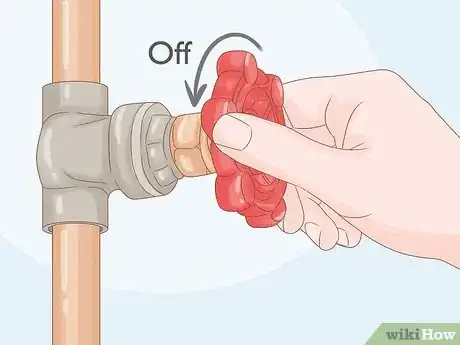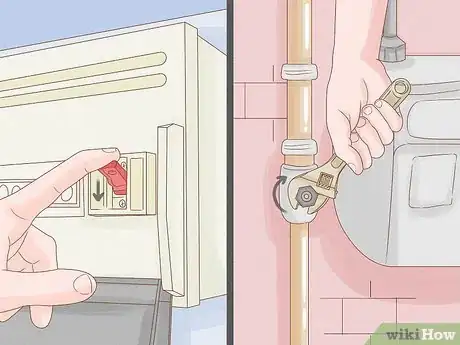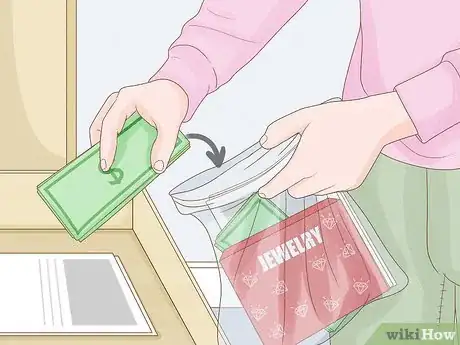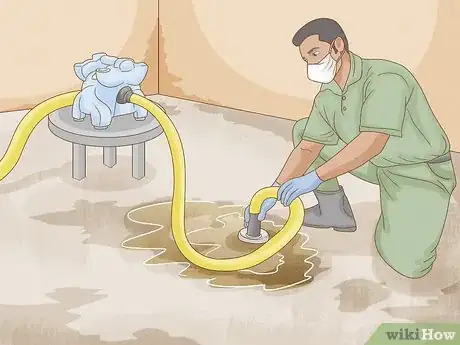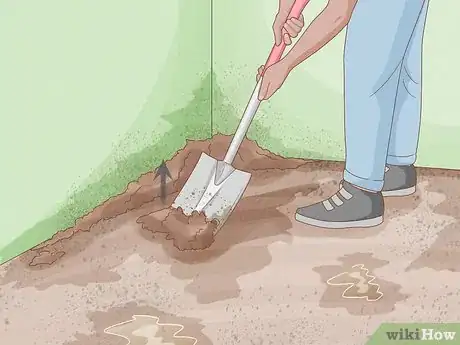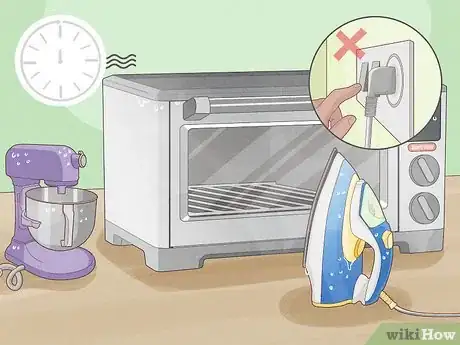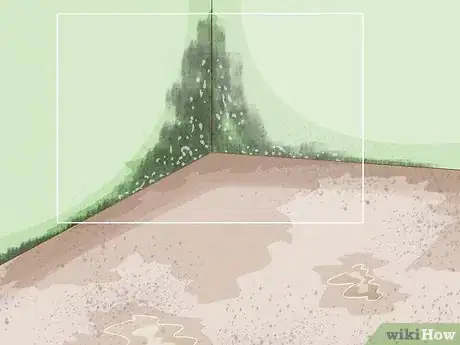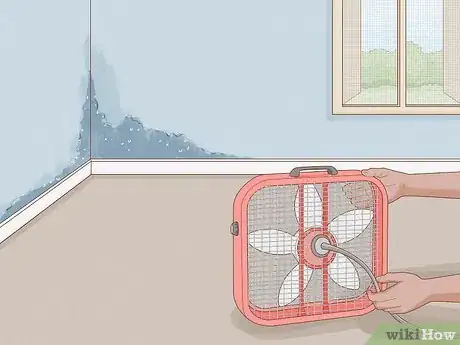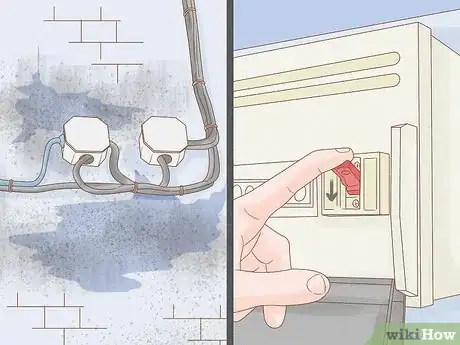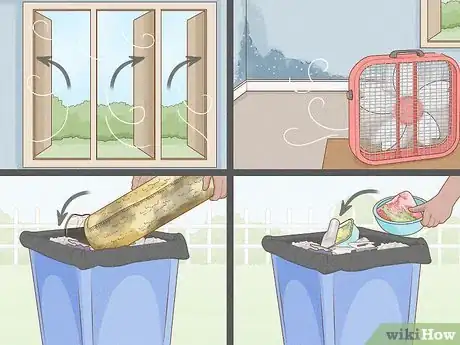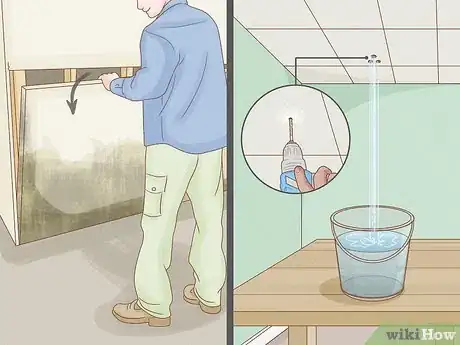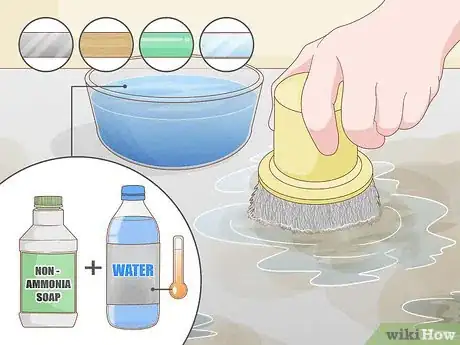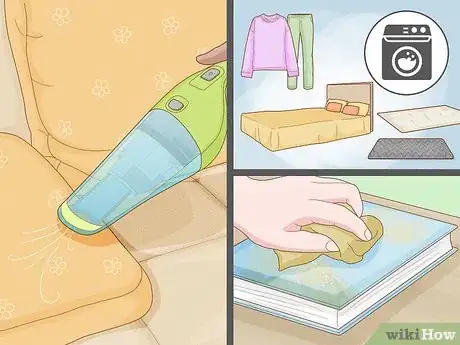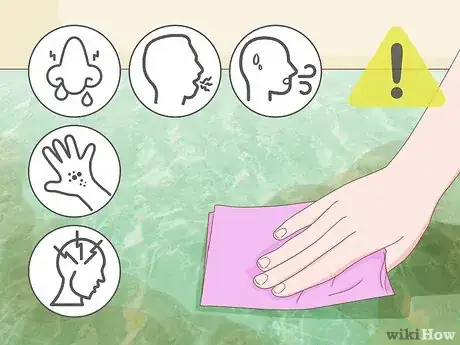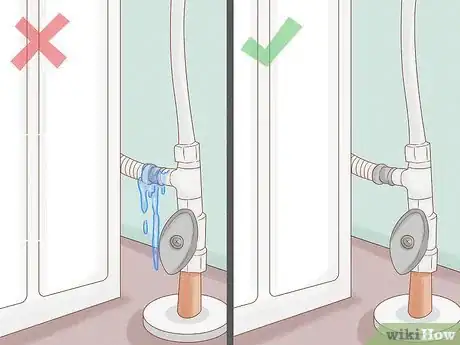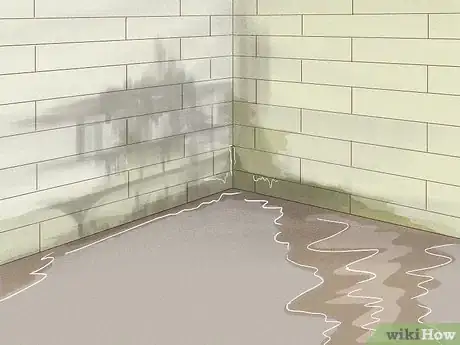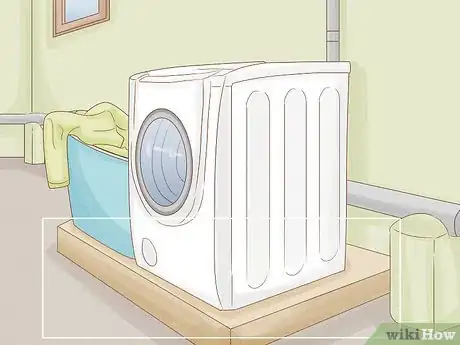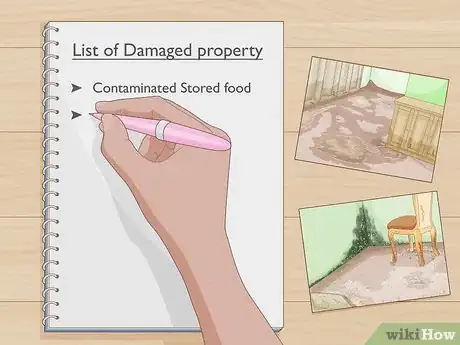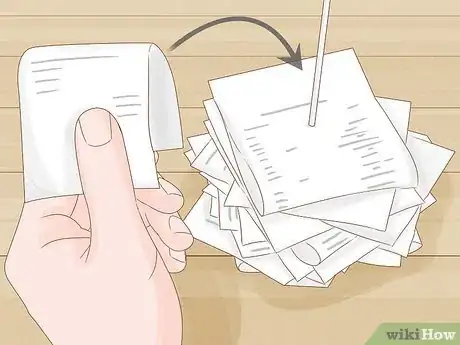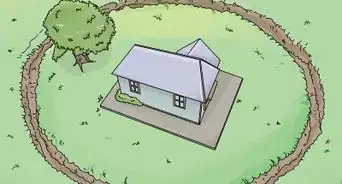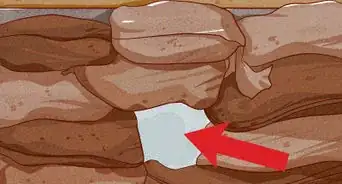This article was co-authored by Ryan Owsiany. Ryan Owsiany is a Drywall and Painting Specialist and the Owner of Patch and Paint Pros in Conshohocken, Pennsylvania. With over two decades of experience, Ryan specializes in interior and exterior house painting as well as drywall, plaster, and water damage repair. Ryan holds a BS in Industrial Engineering from Penn State University. Patch and Paint Pros only employ experienced, friendly painters that understand proper preparation is required to ensure client satisfaction on every painting project.
This article has been viewed 276,946 times.
Water may be essential to human life, but it can spell death for a home. Water damage can cause all sorts of a headache for homeowners, both immediately after the damage occurs and in the long run. From floods to leaky faucets, water damage is a serious pain and can cause significant health and safety issues. Follow this guide to stop, repair, and prevent water damage in your home.
Steps
Fixing Up After a Flood
-
1Stop the flow of water. If the flooding has been caused by a burst pipe or a water heater failure, shut off the main water line for your home.
- Get in touch with an expert immediately if you cannot tell from where the water is coming.
-
2Turn off the power. If your home is flooded, cut off the electricity and gas from the main source. This isn't as essential for small leaks or puddles, but for large floods turn them off to be safe. [1]
- Do not handle electrical appliances unless you are properly insulated.
- If you have to stand in water to turn off the main electricity, consult with an electrician.
Advertisement -
3Assess the damage. Before you begin your cleanup effort, first determine if rebuilding is even a worthwhile option. Take ample photos and other documentation to show the insurance company.
-
4Rescue your most valuable possessions. If you can, find and remove your most important items from the flooded area, such as heirlooms, money, jewelry, etc. Don't spend too much time extracting and cleaning individual items, as the water is still doing damage to your home.
-
5Get rid of standing water. The longer the water sits, the more damage it will cause. As soon as it is safe, pump out any standing water. If you are dealing with a natural flood, wait to pump until the flood waters have receded below your house.[2]
- Wear proper protective gear. When working in a flooded area, be sure to wear rubber boots, gloves, and a mask or respirator.
- Keep children and pets away from any standing flood water, as it is often contaminated.
- Place the pump at the lowest spot of the flooded floor. If the water is deep, you may need to lower the pump using a nylon rope.
- If dealing with a small amount of flooding, you may be able to use a wet-dry shop vacuum to remove the water.[3] These often only hold 4–5 gallons (15.1–18.9 L), so you may find yourself emptying it often.[4]
-
6Clean up debris. Be careful, as there could be nails and other materials left behind by the flood water.
- Mud left behind by floods often contain a significant amount of toxins. Shovel out as much mud as possible, and spray down your walls with clean water. Make sure to check for mud in air ducts, as it will be hazardous when it dries.
- Snakes and rats may seek shelter in your home after a flood
-
7Allow appliances to air dry. Do not use any appliances or outlets until they have had enough time to completely dry. Check with each manufacturer for recommended action.
Vanquishing Mold and Mildew
-
1Detect the mold. Mold can be visible, but it can also grow in air ducts, crawl spaces, rafters, and between walls. If you can't see any mold, but you detect a noticeable musty earth smell, you most likely have mold growth that you can't see.
-
2Act quickly after discovering water damage. Mildew and mold will begin developing within 24-48 hours of exposure to moisture. It will quickly continue to grow until the moisture is completely removed and the mold is exterminated.[5]
-
3Turn off the power. If any cables or wiring are wet or moldy, shut the power off before cleaning. Have an electrician examine the wiring before turning the power back on again.
-
4Dry out the area. You will want to dry out the moldy or wet area as quickly as possible to prevent the mold from spreading. The longer you leave an area wet, the more likely mold will form.
- Open the windows if humidity outside is lower than inside.
- Use fans to remove moisture only if mold has not started growing. Fans can spread mold spores to other areas.
- Remove all wet items from the area, including furniture, carpets, toys, etc.
- Throw away any moldy carpeting. Mold will be almost impossible to remove from the carpet fibers. All other items can be cleaned and disinfected separately.
- Discard any contaminated food products. This means anything not sealed in a watertight container.
-
5Remove moisture from walls and ceilings. If the wall has been water damaged by a flood, you will need to remove all of the wet material, including insulation, wood by-products, and anything else porous.
- Drywall is incredibly porous and should be replaced at the soonest sign of water damage.
- Remove the wallboard to a foot above the watermark.
- You can drain walls by removing the baseboard and drilling holes into the floor. If the water is above the ceiling, pierce a hole in the ceiling and use a bucket to catch any water that drains out.[6]
- Make sure to check the interior of the wall for any hidden mold growth.
-
6Size up the mold growth. If you are faced with a significant amount of mold growth, consider hiring professional cleaners. Mold is very hazardous when being cleaned, because disturbing the mold will cause it to release spores.
- Make sure that the area you are cleaning is well-ventilated.
- Always wear gloves, a mask or respirator, and eye protection.
-
7Clean hard surfaces. Material such as metal, solid wood, plastic, and glass should be washed first with a non-ammonia soap and hot water. Use a stiff brush on rough surfaces such as concrete.
- Use a wet-dry shop vacuum to remove standing water.
- Disinfect all surfaces after cleaning with a 10% bleach solution. Allow the solution to stay on the surface for at least 10 minutes before rinsing with clean water or drying.
-
8Clean porous materials. Upholstered furniture, clothing, bedding, rugs, carpets, books, and more are all porous items. If you can't decide whether to keep a contaminated object or not, err on the side of caution and throw it out.
- Clean the material and then disinfect with a pine-oil cleaner. Let the material dry completely. Monitor the material for several days after cleaning for any fungal growth or odors. If mold returns, be sure to discard the item.
-
9Stop cleaning if you start exhibiting symptoms of mold exposure. As soon as you start feeling adverse effects, stop what you are doing and consult a professional cleaning service. Signs include:
- Breathing difficulties, including wheezing
- Sinus congestion
- Hacking cough
- Eye irritation, redness
- Bloody nose
- Rashes or hives
- Headaches, memory loss[7]
Preventing Future Problems
-
1Refit your house with water-resistant building materials. Replace the materials in flood-prone areas of the house with materials such as stone, tile, sealed concrete, waterproof wallboard.
- Use galvanized or stainless-steel nails and fasteners.
- Put indoor/outdoor carpeting in basements.
- Fit a 'Remote stopcock' - giving you much better control over your mains water supply
- Use water-resistant glues.
-
2Check for leaks and cracks. Check around every door and window to ensure that the seals are watertight. Look for discoloration in the paint and caulk. Also look for swelling around the frames.
- Replace shingles that are coming loose, and pay extra attention to areas around the chimney and vents.
- Seal any cracks in the foundation. Water in the foundation can cause serious damage to your home's structure.
-
3Fix faulty plumbing. Any leaking pipes, clogged drains, and malfunctioning drainage systems should be fixed or replaced.
- Check washing machine and dishwasher hoses to make sure that they aren't cracked.
-
4Prevent seepage. Make sure that drainage pipes and gutters drain water away from the house, and that all the joints are all properly sealed.
- If your gutters start overflowing after 15 minutes of sustained heavy rain, install additional downspouts to help with flow.
- Make sure that the grounds around the house slope away from the home to keep water from the foundations and basement.
-
5Raise your appliances. If your basement is prone to flooding, put your appliances on risers to keep them out of small floods.
- Raise anything that could get damaged: washer, dryer, furnace, water heater, wiring, and any personal items.
Filing a Claim
-
1Call your insurance agent. The sooner that you get in contact with an insurance agent, the sooner your claim can be processed. Your protection will depend on your coverage, and your insurance agent will be able to get the process started.
-
2Make a list. List all of your damaged property before beginning the cleanup process. Include pictures and video evidence if possible.[8]
- Let your claims adjuster know when you are disposing of health hazards, such as contaminated food. It can still be claimed, so they need to know about it.
- Ask about keeping samples. Sometimes you will need to keep samples of damaged property, such as a piece of rug, for claim purposes.
-
3Keep all of your receipts. During the cleanup process, keep receipts for all of your supplies and any services that you hire. Even motel bills for nights you can't stay in the house count.
Community Q&A
-
QuestionHow do you get flood water out of your house?
 Ryan OwsianyRyan Owsiany is a Drywall and Painting Specialist and the Owner of Patch and Paint Pros in Conshohocken, Pennsylvania. With over two decades of experience, Ryan specializes in interior and exterior house painting as well as drywall, plaster, and water damage repair. Ryan holds a BS in Industrial Engineering from Penn State University. Patch and Paint Pros only employ experienced, friendly painters that understand proper preparation is required to ensure client satisfaction on every painting project.
Ryan OwsianyRyan Owsiany is a Drywall and Painting Specialist and the Owner of Patch and Paint Pros in Conshohocken, Pennsylvania. With over two decades of experience, Ryan specializes in interior and exterior house painting as well as drywall, plaster, and water damage repair. Ryan holds a BS in Industrial Engineering from Penn State University. Patch and Paint Pros only employ experienced, friendly painters that understand proper preparation is required to ensure client satisfaction on every painting project.
Drywall & Painting Specialist Airflow is one of the best ways to dry up water, so open your windows or turn on fans or your air conditioner. A dehumidifier will also help. You an also call a water damage restoration company.
Airflow is one of the best ways to dry up water, so open your windows or turn on fans or your air conditioner. A dehumidifier will also help. You an also call a water damage restoration company. -
QuestionWhat product should I spray on the studs after removing the sheet rock?
 Community AnswerUse an antimicrobial or sporicidal product because it will kill more kinds of bacteria including mold.
Community AnswerUse an antimicrobial or sporicidal product because it will kill more kinds of bacteria including mold. -
QuestionWhat product should you spray on the studs after removing the sheet rock?
 Community AnswerSporicidin. Bleach does not kill mold! You can find Sporicidin at a janitor supply store.
Community AnswerSporicidin. Bleach does not kill mold! You can find Sporicidin at a janitor supply store.
References
- ↑ http://www.safeco.com/homeowners-insurance/do-more/what-to-do-after-a-major-water-leak-or-flood
- ↑ http://www.idph.state.il.us/envhealth/factsheets/flood_n_sewer_cleanup.htm
- ↑ Ryan Owsiany. Drywall & Painting Specialist. Expert Interview. 20 May 2021.
- ↑ http://homeguides.sfgate.com/pump-water-out-basement-27599.html
- ↑ http://www.fema.gov/pdf/rebuild/recover/fema_mold_brochure_english.pdf
- ↑ Ryan Owsiany. Drywall & Painting Specialist. Expert Interview. 20 May 2021.
- ↑ http://www.fema.gov/pdf/rebuild/recover/fema_mold_brochure_english.pdf
- ↑ http://www.redcross.org/images/MEDIA_CustomProductCatalog/m4540081_repairingFloodedHome.pdf
